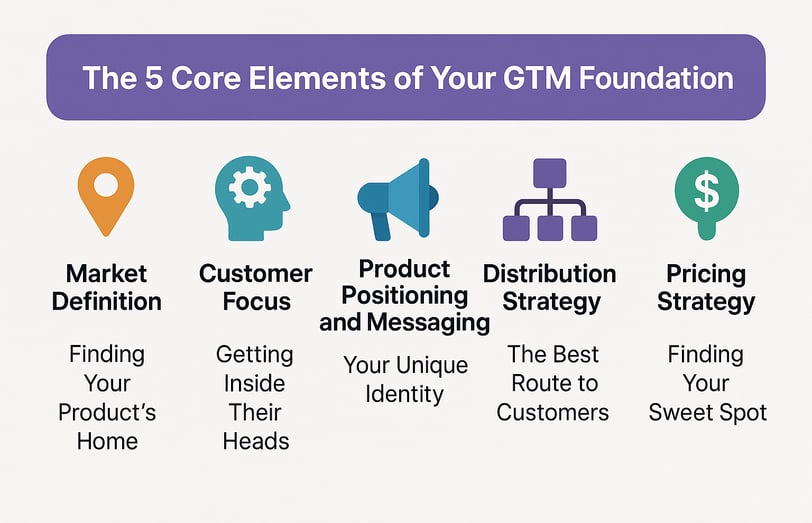The Ultimate GTM Blueprint for B2B Startups: From Idea to Execution
GROWTH
6/4/20255 min read


Every month, roughly 300 brilliant B2B products launch. Within 18 months, 270 of them are dead.
Not because they solved fake problems. Not because the market wasn't ready. But because they confused building something great with building something sellable.
Here's the brutal truth: Your potential customers are already solving their problems maybe inefficiently, maybe expensively, but they're surviving. Your job isn't just to build something better. It's to prove that switching to your solution is worth the risk, cost, and effort.
Your GPS to Revenue: What GTM Really Means
Think of your GTM strategy like driving to a new city. You wouldn't just get in your car and start driving, hoping you'll eventually stumble onto the right street. You'd use GPS.
Your go-to-market strategy is that GPS. It's your comprehensive action plan that shows you how to launch your product, reach your ideal customers, and build sustainable revenue.
It answers the five questions that determine whether your startup thrives or joins the graveyard of "almost-made-it" companies:
➡️ Who exactly needs what you've built?
➡️ What specific problem are you solving for them?
➡️ How will you reach these people?
➡️ Why should they choose you over their current solution?
➡️ When and where will you engage them?
Here's the thing most founders miss: These aren't questions you answer once and forget. They're questions you refine as you learn more about your customers.
The 5 Core Elements of Your GTM Foundation
Before we dive into tactics, let's talk about the five pillars that hold up every successful GTM strategy. Miss one of these, and everything else crumbles.
1. Market Definition: Finding Your Product's Home
This isn't about saying "we target small businesses." That's like saying "we target humans who breathe."
Think about it like this: Where does your product belong in the business ecosystem? What market conditions, trends, and dynamics affect your potential customers?
Maria, who runs a successful HR software company, puts it this way: "I don't target HR departments. I target HR directors at 50-200 person companies who are spending more than 10 hours a week on manual onboarding tasks and losing new hires because their process feels like paperwork from 1995."
See the difference?
2. Customer Focus: Getting Inside Their Heads
What keeps them up at 2 AM?
What would make their Monday morning feel less overwhelming?
What metrics actually matter to their boss?
Here's a trick I learned from a sales mentor: Don't ask customers what they want. Ask them what happens if they don't solve their current problem.
The answers will shock you.
3. Product Positioning and Messaging: Your Unique Identity
Your positioning isn't what you think your product does. It's what your customers believe it does for them.
Tom, who built a cybersecurity tool, thought he was selling "advanced threat detection." His customers thought he was selling "peace of mind so I can sleep at night without worrying about data breaches."
Guess which message closed more deals?
4. Distribution Strategy: The Best Route to Customers
There are three main routes to your customers:
Direct sales: You talk to them directly
Channel partners: Someone else introduces you
Self-service platforms: They find and buy from you
The route you choose depends on how complex your product is and how your customers prefer to buy.
5. Pricing Strategy: Finding Your Sweet Spot
Here's something nobody talks about: Your pricing strategy affects everything from customer perception to sales velocity.
Price too low, and people assume you're not serious. Price too high, and you price yourself out of conversations.
The sweet spot? Find out what your solution is worth to customers, then price accordingly.
The 8-Step GTM Blueprint
Step 1: Figure Out Who Actually Wants Your Product
Don't build for "everyone" - build for someone specific. Create detailed profiles of your ideal customers:
Company size and industry
Role and responsibilities
Problems they're trying to solve
How they make buying decisions
Budget and timeline constraints
Talk to real prospects. Survey existing customers. Look at competitor customer bases. Get specific about who you're targeting.
Step 2: Nail Your Value Proposition
Your value prop needs to answer: "Why should I buy this instead of doing nothing or buying from someone else?"
Use this framework:
For [specific customer type]
Who struggle with [specific problem]
Our product [delivers specific outcome]
Unlike [alternatives] because [key differentiator]
Test it with real prospects. If they don't immediately get it, keep refining.
Step 3: Make Sure Your Product is Ready
Before you start selling, ensure you can actually deliver:
Core features work reliably
User experience doesn't suck
You can support customers when things break
Pricing makes sense for the value delivered
You have case studies or proof points
Don't launch until you're confident that customers will be successful.
Step 4: Build Your Launch Plan
Map out exactly how you'll execute:
Set clear goals: Revenue targets, customer numbers, market share objectives
Define activities: What you'll do, when you'll do it, who's responsible
Segment your market: Prioritize which customers to go after first
Allocate resources: How much money and time you'll spend on each channel
Step 5: Choose Your Sales and Distribution Model
How will customers actually buy from you?
Direct sales: You sell directly to customers
Pros: Full control, higher margins, direct relationships
Cons: Expensive, slow to scale
Self-service: Customers buy online without talking to anyone
Pros: Scales efficiently, lower costs
Cons: Works only for simple products
Channel partners: Other companies sell for you
Pros: Faster market entry, leverages existing relationships
Cons: Less control, shared margins
Most startups use a hybrid approach - direct for large deals, self-service for smaller ones.
Step 6: Execute Your Marketing Strategy
Pick 2-3 channels and do them well rather than spreading yourself thin:
Content marketing: Blog posts, guides, videos that educate prospects
Paid advertising: Google Ads, LinkedIn ads, industry publications
Email marketing: Nurture leads and stay top-of-mind
Events: Conferences, webinars, workshops
Partnerships: Joint content, co-marketing, referrals
Track what works and double down on those channels.
Step 7: Get Customer Acquisition Right
Design your funnel to convert prospects into customers:
Lead generation: How you get people interested
Lead qualification: How you identify good prospects
Sales process: How you move prospects to purchase
Onboarding: How you get new customers successful quickly
Expansion: How you grow revenue from existing customers
Measure conversion rates at each stage and optimize the weakest points.
Step 8: Measure and Improve
Track the metrics that actually matter:
Revenue metrics:
Monthly Recurring Revenue (MRR)
Customer Acquisition Cost (CAC)
Customer Lifetime Value (CLV)
Payback period
Growth metrics:
Lead conversion rates
Sales cycle length
Churn rate
Net revenue retention
Review performance monthly. Kill what's not working, scale what is.
Building Your GTM Team
Start small and focused:
Product Marketing: Messaging, positioning, competitive analysis
Sales: Lead qualification, demos, deal closing
Marketing: Lead generation, content creation, campaign execution
Customer Success: Onboarding, support, expansion
As you grow, add specialists. But initially, people wear multiple hats.
Tools You Actually Need
Don't over-engineer your tech stack early on:
CRM: Track prospects and customers (HubSpot, Salesforce, Pipedrive)
Marketing automation: Nurture leads (HubSpot, Mailchimp, ConvertKit)
Analytics: Measure performance (Google Analytics, Mixpanel)
Communication: Talk to customers (Intercom, Zendesk)
Add complexity as you scale, not before.
The Bottom Line
The path from idea to execution isn't always straight. There will be setbacks, surprises, and moments when you question everything.
But with a solid GTM blueprint, you'll have the roadmap you need to turn your brilliant idea into a thriving business.
If you're ready to accelerate your GTM journey, let's talk. At BriskFab, we specialize in transforming B2B tech companies into high-performance revenue engines. We'll help you build the comprehensive strategy and execution framework you need to scale, from lead generation and brand building to AI-powered process automation that keeps you focused on high-value activities.
Schedule a strategic consultation with our team to discuss how we can help build your revenue engine and compress your path to market leadership.
Don't let your brilliant solution get lost in the noise. The market is waiting, now it's time to help them find you.


